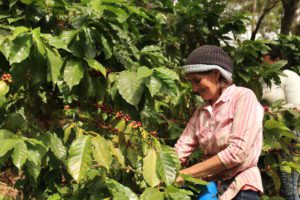When we think of coffee, sometimes fruit can seem like the direct opposite, taste-wise. Certain coffees can taste like hot chocolate when doctored up. Roasted coffee beans are dark and bitter. Sometimes, brewed coffee has slight citrusy flavors. Although brewed coffee can be bitter and dark or remind us more of hot chocolate, a coffee bean’s origin is surprisingly fruity. Coffee “beans” are the seeds inside of coffee fruit. There are usually two seeds inside each coffee cherry. The notes of some great coffees do indicate this fruit-based heritage.

Actually, a tasty coffee-fruit binge was the first way that coffee’s energizing effect was thought to be discovered. It wasn’t a thoughtful human who noticed their own burst in energy. Hyper goats who had eaten coffee fruit tipped off their herder, Kaldi, in Ethiopia. He noticed an uptick in his goats’ activity level after eating coffee fruit. Did the goats bound and jump for joy, or just eat grass a little faster? We’ll never know! This story of coffee’s discovery probably dates back to before the sixteenth century.
Coffee fruit, also known as a coffee cherry or berry, is slightly sweet. It and similar red fruits like large cherries and berries aren’t always the sweetest. Coffee fruit does contain antioxidants that are healthy though. They have a floral aroma and are used as teas, which is easy to imagine considering they contain caffeine.
Who Eats Coffee Fruit?
Since coffee fruit isn’t a big deal taste-wise, it’s not often eaten outside of the coffee belt near the equator. Coffee fruit doesn’t offer big juicy bites like a peach or watermelon. Only a bit of fruit flesh surrounds the seed (bean). Perhaps that’s why it’s not shipped outside its native region like mangos, pineapples or Asian starfruit that venture far. Admittedly, these fruity delights taste much better than coffee fruit too.
However, the antioxidants coffee fruit contains are making people take a second look at it. When a food isn’t popular on its own but has positive qualities for health, it often still makes its way to people concerned with health and nutrition. Coffee cherries show up as an ingredient in health foods and supplements. So the answer to “who eats coffee fruit?” is people who live near coffee trees, along with those who consume it in dried or powdered form in distant countries.
Uses for Coffee Fruit
Before getting into the health benefits of coffee fruit, considering the possibilities for caffeinated fruit like a coffee cherry is beyond fun. In the Southern US, an energizing cold beverage has been served for decades: sweet tea. It’s exactly what’s needed at lunch or 3 pm on a hot and humid day. However, bitter unsweetened tea could be avoided by way of adding a coffee-fruit component or tea. Many people want to avoid traditional sweet tea too because of the loads of sweetener blended into it. Putting the pulp, or fleshy part of the coffee fruit, into a smoothie with sweeter fruits can bring the best of both worlds: energizing and healthily sweet.
Fun Possibilities for Coffee Fruit
Eating something both energizing and fruity is excellent in the heat. Whether it’s dry heat or a fog of humidity lurking outside, a fruity pick-me-up can help you power through outdoor activities. Eating coffee fruit at the end of a race, like a 5k, would be a big hit. It doesn’t contain a large amount of caffeine.
Other fun-focused ideas pay homage to the story of Kaldi and his goats who discovered coffee in Ethiopia. As advocates of coffee beans from Honduras, and of tropical fruit too, it’s fun for us to see how different parts of the coffee tree create great times worldwide. Serving coffee fruit before Latin dance class sets a great tone. A bit of juice-based energy gives a boost before tackling the most intensive dances like the Mambo and Cumbia.
Other options might be serving coffee fruit for outdoor work like landscaping, gardening or farming. Likewise, construction projects pair well with coffee fruit. True honoring of Kaldi and his goats who possibly jumped would be paid by offering it at a trampoline park. However, that level of caffeine before bounding is up to parents’ discretion!
Health Benefits of Coffee Fruit
While the health benefits of coffee fruit shouldn’t be overblown, as was done with the açai berry, there are a few attributes. Coffee fruit does show positive effects in animals. The antioxidants contained within the fruit, the benefits of which are undeniable, are positive. It may benefit brain health as well.
Caffeine itself is an antioxidant. Coffee has gotten some attention for antioxidants. Overall, coffee has both drawbacks and positive effects. Coffee cherries have around 20 milligrams of caffeine. That’s about a fifth of the amount in a cup of coffee.
Coffee cherries contain caffeic acid. Caffeic acid is present in many types of diuretics, or drinks that dehydrate. Tea and coffee, along with wine, naturally contain caffeic acid. It helps reduce inflammation and the chances of cancer. Coffee fruit may also boost BDNF, meaning brain-derived neurotrophic levels. These improve cognitive function.
One potentially promising benefit of coffee fruit is that it may help with weight loss. Chlorogenic acid is present in coffee cherries. It’s been tied to boosting fat-burning ability. In one study, coffee helped decrease body fat. Most interesting, it seemed to target belly fat.
Still, it’s important to take the health benefits of coffee and its fruit as a positive, but not a supreme health or weight-loss solution. Caffeine may worsen anxiety. It can pose risks for people with cardiovascular problems.
Sustainable Coffee Processing and Delectable Coffee

Coffee fruit is valuable in its own right and the possibilities for health benefits are exciting. Subida Coffee Co. already ships gourmet coffee beans from Honduras. This non-profit supports the local Honduran community. In particular, they help educate teenagers who would not be educated otherwise. An optional subscription model makes regularly supporting educational and empowerment efforts easy. It also does the work of bringing delectable coffee into your home.
Rainforest Alliance certified and grown at the direction of local agricultural engineers, Subida stands out from the crowd of Central American coffees. Honduran coffee brands, especially single-origins like Subida, are ranking better each year. Subida helps establish a direct connection that supports a fair growing situation.

